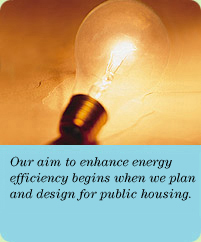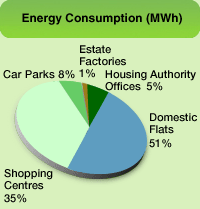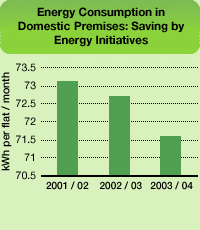

 |
 |
||
|
 |
 |
 |
 |
 |
 |
 |
 |
||

|
|
|||||||||||||||||||
| Enhancing Energy Efficiency We continue to implement measures to enhance energy efficiency and energy management in our premises. Our efforts over the past year are highlighted below. "Micro-climate" Studies
Using sophisticated computer software, we have simulated the pedestrian wind environment, natural ventilation, solar penetration, daylight, indoor air quality and energy use for several projects under planning, including those in Tin Shui Wai, Tung Chung, Lam Tin, Choi Wan Road and Upper Ngau Tau Kok. |
||||||||||||||||||||
|
Energy Saving Equipment
We also completed a trial in an office area on installing an energy saving "Luminosity Enhancement Jacket" (LEJ). The data is being studied and LEJ will be adopted as applicable. Energy Efficient Management Energy management is another important means of reducing energy consumption. Our efforts during the past year have included:
|
|||||||||||||||||||
|
Energy
Efficiency Registration Scheme for Buildings
The registration of six existing shopping centres had been completed at the end of March 2004. This demonstrated our initiatives in energy saving for lighting and electrical installations. We also continue to adopt the BEC in all building designs. We have put into practice some innovative energy saving designs in Choi Ming Shopping Centre in Tseung Kwan O. Such designs saved an additional 10% in energy consumption compared with other commercial buildings of a similar structure and occupancy rate. The Choi Ming Shopping Centre was the first building in Hong Kong certified with the performance-based BEC[2] under the scheme. To date, most of rental estates with standard block designs have also been awarded the Energy Efficiency Registration Certificate. Energy Consumption |
|||||||||||||||||||
  |
Our domestic properties constitute the most to the total energy consumption, our energy efficiency initiatives have led to a gradual decrease in consumption per flat per month. As the second higher energy consumption, we have also focussed on reduction initiatives in our shopping centres. Our initiative to reduce energy consumption by water-cooled chillers in our Wo Che Shopping Centre achieved a year-on-year energy cost reduction of HK$0.1 per square metre per day. In 2003 / 04 the total electricity consumption of the HA Headquarters decreased by 8.2% year-on-year. Compared with other Government departments where headquarters electricity consumption ranged from 2% increase to 14% decrease, the HA has performed satisfactory.[3] Our performance was achieved by reducing the operational hours for our air-conditioning and lighting systems, and through the support of our staff in adopting energy saving programmes and practices. |
|||||||||||||||||||